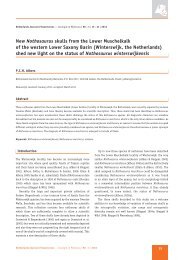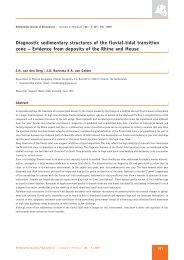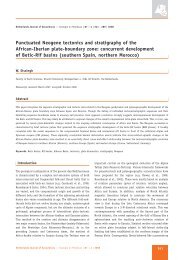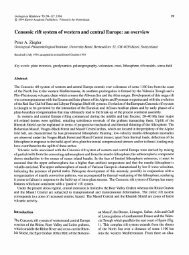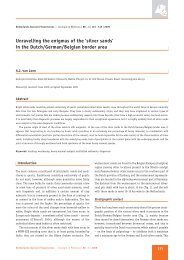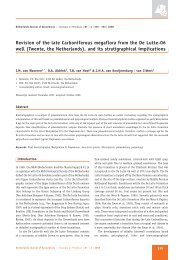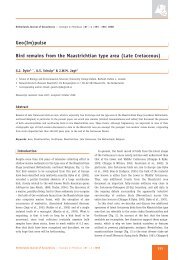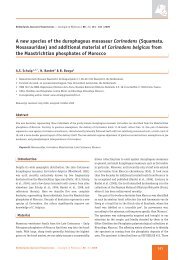Neotectonics of the Roer Valley rift system. Style and rate of crustal ...
Neotectonics of the Roer Valley rift system. Style and rate of crustal ...
Neotectonics of the Roer Valley rift system. Style and rate of crustal ...
Create successful ePaper yourself
Turn your PDF publications into a flip-book with our unique Google optimized e-Paper software.
146<br />
(i) The sou<strong>the</strong>rn segment, showing <strong>the</strong> strongest subsidence,<br />
is referred to as <strong>the</strong> <strong>Roer</strong> <strong>Valley</strong> Graben<br />
(formerly named Central Graben (Remmelts &<br />
Duin 1990; Geluk 1990) or Ru(h)r Graben (Ziegler<br />
(1992)).<br />
(ii) The nor<strong>the</strong>rn segment is <strong>the</strong> Peel-Venlo Block<br />
(Van Rooijen et al. 1984), <strong>the</strong> deepest part<br />
<strong>of</strong> which is referred to as <strong>the</strong> Venlo Graben.<br />
Three NW-oriented, principal displacement zones<br />
(PDZs) bound <strong>the</strong> segments: <strong>the</strong> left-stepping<br />
S<strong>and</strong>gew<strong>and</strong>-Feldbiss-Rauw-Rijen faults in <strong>the</strong><br />
southwest; <strong>the</strong> Peel-<strong>Roer</strong> Boundary Fault forming<br />
<strong>the</strong> central element, <strong>and</strong> <strong>the</strong> Viersen Fault in <strong>the</strong>'<br />
nor<strong>the</strong>ast. To <strong>the</strong> south <strong>the</strong> area is flanked by <strong>the</strong><br />
rising South Limburg Block. The nor<strong>the</strong>rn flanking<br />
region (<strong>the</strong> Krefeld High) will not be considered.<br />
The two main segments have been faulted. These<br />
segments display subtle to strong differences in vertical<br />
movements, both expressed in <strong>the</strong> sedimentary<br />
record as well as in <strong>the</strong>ir geomorphology. Analysis <strong>of</strong><br />
<strong>the</strong>ir dynamics in space <strong>and</strong> time is important for a<br />
comprehensive view on <strong>the</strong> detailed evolution <strong>of</strong> <strong>the</strong><br />
<strong>rift</strong> <strong>system</strong> dynamics, as discussed below.<br />
State <strong>of</strong> stress<br />
The regional <strong>crustal</strong> motions are controlled by <strong>the</strong> interplay<br />
<strong>of</strong> at least three intraplate stress fields.<br />
(i) The subsiding North Sea Basin gene<strong>rate</strong>s a flexural<br />
marginal bulge. The Pleistocene highs in <strong>the</strong> sou<strong>the</strong>rn<br />
<strong>and</strong> eastern Ne<strong>the</strong>rl<strong>and</strong>s may be an expression<br />
<strong>of</strong> this bulge which forms waterdivides: to <strong>the</strong> south<br />
with <strong>the</strong> W-E running `Flemish <strong>Valley</strong>' in Belgium<br />
<strong>and</strong> to <strong>the</strong> east with <strong>the</strong> S-N running Ems valley.<br />
The PDZs dissect this bulge. The forming <strong>of</strong> a<br />
bulge may explain while fault zones in this region<br />
have a pronounced character in comparison with<br />
<strong>the</strong> poorer expressions more basinward (Fig. 1).<br />
(ii) The horizontal principal stresses in western Europe<br />
indicate deep-seated stresses away from <strong>the</strong> Alpine<br />
collision front in a northwest direction (Klein &<br />
Barr 1986; Philip 1987; Mueller et al. 1992). This<br />
stress field (Hma,) opens up <strong>the</strong> <strong>rift</strong> <strong>system</strong> by tensional<br />
forces (H,,,,i,,,) as is indicated by stress measurements<br />
(Ahorner et al. 1983; Illies & Greiner<br />
1978).<br />
(iii) The Midi-Aachen Thrust (Meissner et al. 1983)<br />
sepa<strong>rate</strong>s <strong>the</strong> study area from <strong>the</strong> Ardennes <strong>and</strong><br />
Rhenish Shield to <strong>the</strong> sou<strong>the</strong>ast. Mapping <strong>of</strong> <strong>the</strong><br />
main (palaeo-)water divides indicates a pattern <strong>of</strong><br />
alignments oriented parallel to this thrust (Fig.<br />
METHOD<br />
For <strong>the</strong> Over Maas, every climatic cycle <strong>of</strong> 100 ka<br />
is regist<strong>rate</strong>d as an individual terrace under a<br />
0.05< uplift <strong>rate</strong>



